Barks Blog
Pet Professional Guild links up with Victoria Stilwell to support National Puppy Mill Awareness Day
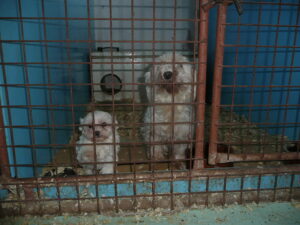
National Puppy Mill Awareness Day falls on September 27, 2015 and the Pet Professional Guild (PPG) has partnered with renowned dog trainer, television personality and PPG Special Counsel member, Victoria Stilwell, in an effort to highlight the plight of millions of dogs held in puppy mills nationwide.
According to the American Society for the Prevention of Cruelty to Animals , a puppy mill is a “large-scale commercial dog breeding operation where profit is given
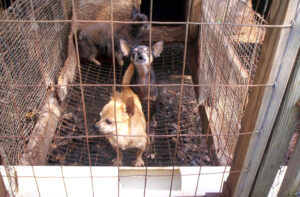
priority over the well-being of the dogs.” The National Puppy Mill Project states that there are currently 800,000 adult breeding dogs “suffering in puppy mills.” The organization’s website says it is “legal to confine adult breeding dogs to small, wire-bottomed cages, only 6 inches longer than the dog on all sides, often stacked on top of other cages, for life. They live in overcrowded, squalid conditions, neglected, starved and left sick and injured without medical care or relief from overwhelming pain. Most females are bred as frequently as possible, with no recovery time in between litters, and when they are no longer able to ‘produce’ they are discarded like garbage. Recent studies confirm that dogs confined in puppy mills for breeding purposes demonstrate impaired health and diminished welfare and carry emotional scars for years.”
Stilwell recently released a video detailing a large puppy mill bust by Cherokee County Animal Shelter and Cherokee County Marshal’s Office in Georgia that she was involved in last year.
“The puppy mill had been operating since the 1980s but fortunately all dogs and puppies were rescued from the horrific facility and were cared for at the Cherokee County Animal Shelter until they were ready for rescue or adoption,” said Stilwell. “Many pregnant females gave birth shortly after the bust, raising the final total of rescued dogs even further. The owners of the puppy mill plead guilty to 25 charges of animal cruelty and were sentenced to 25 consecutive years of probation.”

To raise awareness, PPG asked members to share photos and stories of dogs rescued from puppy mills. One of the incredible tales submitted included that of Hoppy, rescued at four months with his infected back leg “barely hanging on,” according to guardian Dawn Goehring. The leg had to be amputated. Hoppy was adopted and returned – twice – for resource guarding and being “hyper” before coming to Goehring. He now goes into schools to teach pet responsibility, bite prevention and to discourage discrimination against both pets and people with disabilities.
Another story came from Nikki Finn-Loudenslager who adopted beagle/terrier mixes, Poppy and Jasmine, from the Teller County Regional Animal Shelter, Colorado in March 2009 after a puppy mill in Kansas was shut down.

“They were just five months old, physically they were in pretty good health considering the circumstances. Mentally, however, we had a lot of work to do. It took nearly six weeks of daily positive reinforcement, counterconditioning [and] patience… for them to accept human contact from me [and] another month or so to accept contact from my husband. Then the real work began of learning how to walk on leash, travel in the car without anxiety, desensitize to common household noises, [house] training [and] building confidence to interact with new dogs and new people. It was a long road to recovery, but today [Poppy and Jasmine] are the types of dogs that I can take anywhere.”
“Dogs who come from backgrounds such as those in puppy mills are often deprived of human attention and environmental and mental enrichment, are poorly socialized, have grown up in deplorable conditions and may well carry emotional scars as a result,” said Niki Tudge, PPG’s founder and president. “Some dogs adapt to their new lives quite quickly while others may need some help. While it may be time consuming to rehabilitate them, it is almost always possible once one has an understanding of the dog’s emotional state and how to modify his behavior. This is why force-free, positive, humane training that is scientifically sound is so important. Dogs who are fearful and/or anxious can be prone to aggressive behavior because they have no other benchmark. This is where qualified, highly educated and experienced PPG trainers and behavior consultants can help new pet guardians work through any potential issues and put a plan in place to build a dog’s confidence levels to help him integrate into family life and our human world in general.”
National Puppy Mill awareness Day takes place on September 27, 2015.
Here are some more PPG members’ wonderful rescue dog tales:
From Stephanie Presdee:

Unfortunately the owner of Nancy and another elderly rough collie and a border collie died, leaving the two dogs to fend for themselves. The social services were eventually contacted and the police had to break in, a frightening process for the dogs, who were covered in urine and faeces. Other than that we had no more details. The dogs were taken to a council pound, which, however kind the carers are, are usually cold concrete runs with metal gates that are noisy for sensitive breeds. Fortunately a representative of Rescue Animals in Need (RAIN) visited the pound and spotted them and had them transferred to rescue kennels while the breed rescues were contacted. The carers in the rescue kennels named them as not even their names were known.
Nancy was very stressed and did not lift her head up for weeks. She was also in season and nine weeks later had to have an emergency operation as she developed an open pyometra. Recovery, with being older and with her thin skin, took a while and she developed a seroma on her wound site. She collapsed a few times, her gums were white and we were very worried. However, a year later she has changed from a stressed quiet dog to a playful naughty one who plays with a squeaky ball, runs in the fields with her household friend, a young flatcoat retriever, and has won rosettes at companion shows in the veteran and fun classes.
From Mandy Jones:
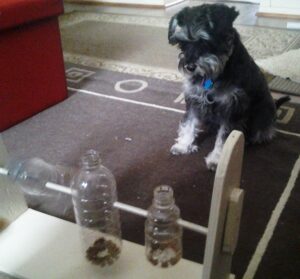
In honor of dogs in puppy mills everywhere, here is the story of Daisy, which just goes to show how there are no quick fixes for the lack of socialization and early mental and environmental stimulation suffered by these dogs. Thanks to Mandy Jones for sharing: “I am the very proud guardian to Daisy, a puppy farm rescue dog, who was rescued along with approximately 140 other dogs here in South Australia. The dogs lived in disgusting filth, had no bedding and were on dirt floors where they would also have their puppies. Many of the dogs were pregnant or had young pups and some were whelping in the vans as they were being moved. Due to the high number of dogs, the RSPCA put out a call for foster homes and through my work as a vet tech, we, as a clinic, offered to take one pregnant bitch, a miniature Schnauzer. She was sad and scared, curled up right at the back of her cage not wanting to interact with her in any way. I offered to take her home, where I already had one Chihuahua, Minnie. Every day I would take this little girl home and the next day I would bring her back to work with me. She would sit on the car seat strapped in and just close her eyes to the world. At home I had got her a dog playpen and she would live in that, with the door open just in case she wanted to come out. When I took her out into the garden, she looked amazed and did lots of sniffing and took her first tentative steps onto the grass. After about a week, she would follow Minnie around. Everywhere Minnie went, Daisy was not far behind and from then on, she did not want to stay in her play pen. Daisy was slowly learning that I wasn’t all that scary and when Minnie would come over for attention, Daisy would start too as well. She couldn’t cope with too much attention but was gaining confidence daily. About a week and a half after first had Daisy, I rang the RSPCA and asked if I could keep her, and fortunately they said yes, as long as she gets desexed and the pups go to the RSPCA. She had her pups one morning at work. All were healthy. Later, when she was spayed, she was found to have five grass seeds in her ears, a broken molar, and her teeth were worn from what we assume was caused from chewing on the bars of her enclosure at the puppy farm.
Daisy’s doing so well now. She can walk alongside me down a fairly busy road, without getting frightened of the cars and trucks, which took about 16 months of desensitization and counterconditioning. We still have a long way to go, and I know she will never be a ‘normal’ dog. She still has what I call meltdowns, where she feels overwhelmed and will just stop, so we get out of where we are and what we are doing and just relax. I am now able to preempt this. She still can’t be in the middle of lots of people or dogs, is very frightened of children under about 12 years old, gets very unsettled when other dogs bark or loud people are around. So we manage the environment as much as possible, and get out of situations that worry her. Every day I silently thank the Adelaide RSPCA and Oscar’s Law for rescuing Daisy and all the other dogs from that horrendous puppy farm.”
From Jennifer Hirakawa:
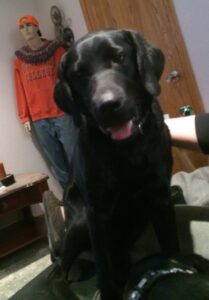
This is Gracie Bell, when she arrived at our home a little over a year ago, she had a broken femur, a broken tibia, and a broken occipital bone. Her former human was sentenced to 1 year on animal cruelty. We were only supposed to rehab her, help her with her fear of humans and them set her up to be adopted. Well as you can see we did the 1st two, but I decided immediately that she was meant for us and our family. Her road has been long and her struggle huge, but she overcame all her fears, and actually likes people now, and she can play and run with all our other dogs. She is wonderful, and that is why her name was changed to Gracie. I am blessed to have her in my life.
From Tamra Temple:

Last Thanksgiving, after hearing about a dog chained to a trailer that was about to be hauled away, I stopped to see the dog, Mo. His owner had been in a nursing home for six months, never to get out, and neighbors had been giving him food and water. His hips were atrophied so badly he could barely walk. Once we got home, I saw that he was unable to sit. The vet was unable to palpate them to check him out since he was in so much pain he screamed at her slight touch. I don’t think either of us expected him to last more than a month before having to be put down due to pain, but now he has enthusiasm for life, lots of affection for me, Bella and the chickens and is pain free. Mo is a miracle senior… after living on a chain for God knows how long, this 15 yr old is finally enjoying life as a house dog.
From Leslie Clifton:
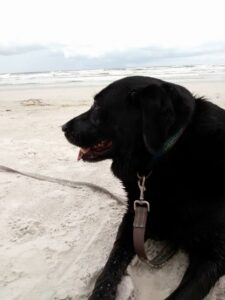
Doobie, now 10, one of 54 labs taken from a West Virginia puppy mill. He was 4 years old and required complete rehab. He was able to pass Certified Therapy Dog test a year ago. He is the best ever.
From Niki Tudge:
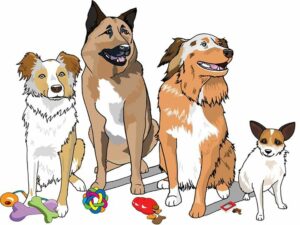
Dobie was rescued from a back yard in 2001 and was my first dog. She is the Kelpie mix second from the left. She started my dog journey. She cost nothing, was worth millions. Bailey, my Red Merle Aussie, came to us from Aussie Rescue at 10 months of age. She had already had five homes and is now 10. Gizmo, the little Jack-achi, was a weekend foster from the Humane Society I was a volunteer Executive Director at and Lara, the Red Merle Border collie, on the far left was a three year fearful dog rehab case I fostered who never left.
Resources: Puppy Mills
Puppy Mills: Facts and Figures , January 2014 (source: Humane Society of the United States)
10,000 – Estimated number of puppy mills in the U.S. (both licensed and unlicensed) 1,924 – Number of USDA Class A and B licensed facilities that breed dogs for the pet trade 167,388 – Estimated number of dogs kept solely for breeding purposes in USDA-licensed facilities 108,802 – Estimated number of female dogs kept for breeding at USDA-licensed facilities 9.4 – Estimated number of puppies per breeding female per year 1,022,740 – Estimated number of puppies produced by USDA-licensed facilities each year 2.04 million – Estimated number of puppies sold annually who originated from puppy mills – USDA-licensed and non-USDA licensed 25% – Estimated percentage of dogs in animal shelters who are purebred 3 million – Estimated number of dogs and cats euthanized by shelters every year in the U.S. $4-$7 – International City/County Management Association budgeting recommendation, per capita, for animal control programs $500,000 – Estimated cost of a puppy mill bust involving 250 animals
Humane Society of the United States: ttp://www.humanesociety.org/issues/puppy_mills/
National Puppy Mill Project: https://nationalpuppymillproject.org
American Society for the Prevention of Cruelty to Animals: https://www.aspca.org/fight-cruelty/puppy-mills
Video Victoria Stilwell in Georgia Puppy Mill Bust: https://www.youtube.com/watch?v=G3WL6Cz4oKA&feature=y…
About Victoria Stilwell
Victoria Stilwell is a dog trainer and behavior expert best known as the host of the international hit TV series It’s Me or the Dog through which she promotes the power, effectiveness and safety of force-free, positive dog training. A best-selling author of three books, Stilwell is editor-in-chief of Positively.com, president of the Victoria Stilwell Academy for Dog Training & Behavior, and CEO of Victoria Stilwell Positively Dog Training (VSPDT). For more information, see: https://positively.com
About The Pet Professional Guild
The Pet Professional Guild is a 501(c)6 a member organization founded on the principles of force-free training and pet care. Its membership represents pet industry professionals who are committed to force-free training, pet care philosophies, practices and methods. Pet Professional Guild members understand force-free to mean: no shock, no pain, no choke, no fear, no physical force, no physical molding, and that no compulsion-based methods are employed to train or care for a pet.

